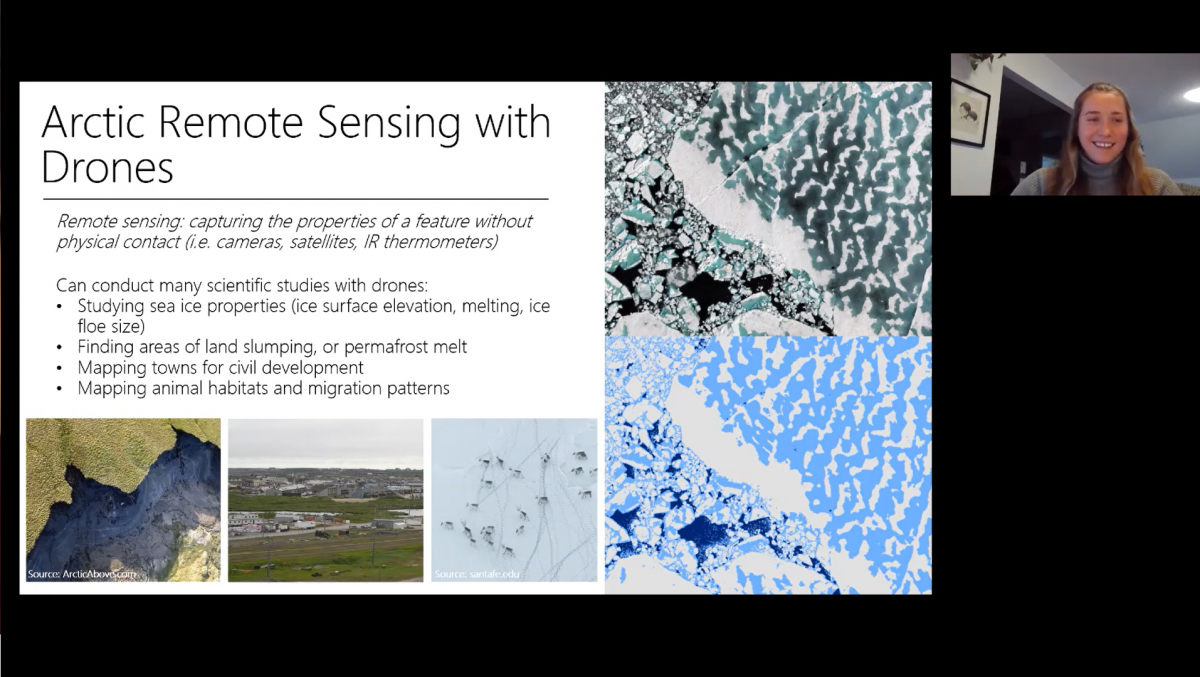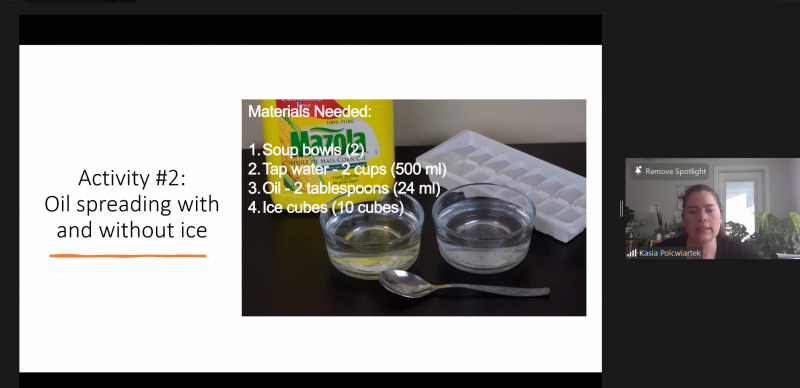
Maddie Harasyn shows the uses of drones in Arctic research at Arctic Science Day
A new virtual experience for Arctic Science Day
An annual science field trip remediated for the digital domain
Manitoba middle and high school students took a more virtual approach to an annual Arctic science field trip in 2021. Most years, students wear extra warm socks for live ice auger demonstrations at Lake Cargrill, Fort Whyte Alive on Arctic Science Day. Although they didn’t strap on their winter boots this year, the kids still had to bring their thinking caps.
More than 1,500 students attended the unique Arctic and climate science workshop with experts in physical and chemical oceanography, sea ice optics, marine mammals, remote sensing, contaminants, and oil spills.
Scientists from the Centre for Earth Observation Science (CEOS) in the Clayton H. Riddell Faculty of Environment, Earth, and Resources at the University of Manitoba gave seminars, demonstrations, and answered students’ questions live through Zoom.
This digital edition of Arctic Science Day was even more accessible than years prior, through a format that allowed more students to participate. The new virtual experience was viewed by students throughout the entire province, including Frontier School Division which hosts Manitoba’s northernmost young learners.
This year’s event didn’t include live ice auger demonstrations, but students had a mixed schedule of information seminars and hands-on learning activities. They asked insightful questions throughout each session, displaying their interest and literacy in science topics. Teachers approved as well.
“The activities provided for Arctic Science Day were great,” says Diane Nickel, French Immersion Teacher 7e année, École Communautaire Leila North. “My students were engaged and loved the connections that were made while having fun.”
Physical oceanography lessons came from faculty research professors Karen Alley and Juliana Marini Marson, as well as postdoctoral researchers Erica Rosenblum and Laura Gillard.
Students learned about sea ice and optics from postdoc Aura Diaz and PhD candidate Lisa Matthes, including lessons on instruments and technology used in the field, and principles like sunlight reflection, scattering, absorption and transmission, with functions like the albedo effect where more light is absorbed by dark colours than bright colours, resulting in rising temperatures from polar ice melt.

Aura Diaz showing how liquid enters an ice core using a colour dye
PhD candidate Tonya Burgers taught aspects of chemical oceanography like how much dissolved carbon is in the Arctic Ocean, and how much carbon in the Arctic Ocean is absorbing from the atmosphere. Burgers also taught concepts like temperature effects on air volume using household materials.
“What happens when CO2 dissolves in water, it reacts with the water and forms carbonic acid,” Burgers tells students, explaining how the process impacts water quality indicators like pH levels.
Students took a break from chemistry for whale watching as they learned about marine mammals and remote sensing methods with researchers Maddie Harasyn, Elizabeth Worden, and Emma Ausen.
Harasyn showed how she pilots drones to study sea ice properties like surface elevation, or to find areas of land slumping, or permafrost melt where indicators of climate change can be found. Harasyn also showed students the Sea ice Environmental Research Facility (SERF) on UM campus, where researchers study different ways of monitoring sea ice with satellites, and what happens to microplastics in sea ice. Students also learned how researchers like Harasyn train machine learning algorithms to identify marine mammals in drone footage.
Ausen described the processes of researching marine mammals, from data collection to analyzing key indicators like abundance and distribution. Worden told students about the impacts of climate change on communities and traditions.
Worden describes “a whole cocktail of climate change” taking place in the Arctic, including “strong storms, earlier ice break-up, changing the timing of migrations, rivers changing their paths, so access to the ocean getting harder, coastal erosion, unpredictable weather conditions,” she lists. “And then there’s also social change which is more complicated and more personalized.”
Postdoc Diana Saltymakova led a session on oil spills with PhD candidates Durell Desmond and Kasia Polcwiartek where students learned about the impacts of oil in the ocean through interactive demonstrations that students followed along with on their own.

Kasia Polcwiartek leading students through activity teaching oil spreading with household items
CEOS Technician Debbie Armstrong wrapped up the day’s programming teaching students the difference between a contaminant (a substance in greater concentration than normal in an environment) and a pollutant (a contaminant that results in adverse health effects within ecosystems). General types of water pollutants include nutrients, decomposed algal blooms, trace metals, pesticides, oil, microplastics, zebra mussels, acid rain, and more.
Students finished Arctic Science Day with the starter tool kit for Arctic science research, having learned, participated, asked questions, and received answers from scientists conducting world-leading research into important environment and climate topics.






